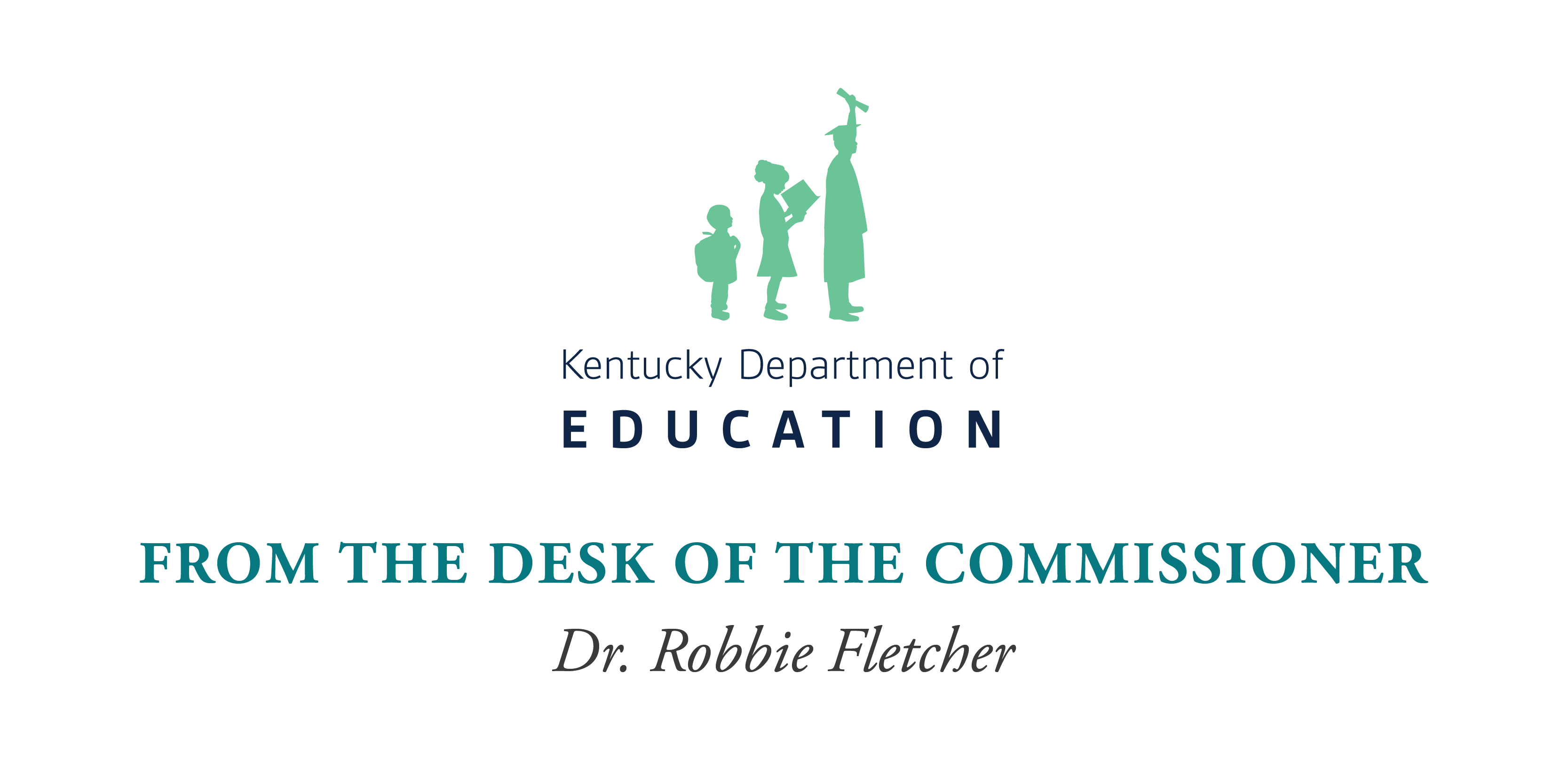
Vice Chair Roger Marcum speaks with the board about the use of readers on state tests during the February Kentucky Board of Education meeting. Photo by Amy Wallot, Feb. 1, 2012
By Matthew Tungate
matthew.tungate@education.ky.gov
While acknowledging parent and teacher concerns, the Kentucky Board of Education decided last week to move forward with a new regulation that would limit the help special-needs students could receive on mathematics and reading fluency portions of the Kentucky Performance Rating for Educational Progress (K-PREP) tests.
The board discussed delaying the new regulation, which prohibits students from receiving help from a reader on state reading comprehension tests and a calculator on some state mathematics tests, until August – the start of the 2012-13 school year.
The discussion arose following a plea from Betty Muntz, executive secretary for Kentucky Council for Exceptional Children and other comments about the regulations.
Muntz, at one point choking back tears, told the board, “Students aren’t prepared this year. Teachers are not prepared this year.”
Associate Commissioner Kevin Brown told the board that more than 50 people sent comments and attended a public hearing on the proposed regulation. Most were concerned and confused about the proposed changes, and many were confused about what they meant.
In response, KDE staff recommended that the board:
1. remove readers on the reading test to send a clear message that schools need to help students become independent readers
2. add a procedure for students with special circumstances, such as those who are blind but cannot read Braille, to apply for additional accommodations
3. require students selected to participate in National Assessment of Educational Progress (NAEP) testing adhere to NAEP rules, which don’t include a reader
4. delay implementing the new requirements until school begins in the fall
The board agreed to the first three recommendations.
Commissioner Terry Holliday told the board implementing the new regulation this year begins a process that needs to happen and establishes more accurate information for the first year of the K-PREP tests.
“I would strongly encourage the board to remove the extension,” he said.
Despite the board’s vote, some schools may begin taking K-PREP tests before the regulation becomes official.
Associate Commissioner Ken Draut told the board that some schools will begin taking K-PREP tests as early as April 19.
The regulation must go before the Education Assessment and Accountability Review Subcommittee, and then House and Senate education committees, Brown said.
“More than likely it’s going to be delayed until the fall of 2012 because of the mechanics of the system,” he said. “I’d be very surprised if we have it though the process by the 19th (of April).”
Rhonda Sims, a director in the Kentucky Department of Education’s Office of Assessment and Accountability, told the board that the percentage of students affected is very small, and the restrictions only affect a limited portion of the K-PREP tests. She also emphasized that students will be allowed to continue using readers and any other accommodations for which they qualify in class throughout the school year.
Ten to 12 percent of all Kentucky public school students have special needs, and 70 percent of those use a reader, Sims said.
Some board members were concerned that students’ grades could be negatively affected by the change. High schools use end-of-course assessments in English II to receive their K-PREP scores in reading. Schools also are encouraged to count end-of-course assessment as much as 20 percent of a student’s grade in those subjects.
Students have been allowed to use readers and calculators on those tests thus far this year if they were part of the students’ approved accommodations.
“It does have a potential impact on students’ scores,” Sims said.
Vice Chair Roger Marcum told the board that he struggles with what is the right thing to do. While he understands that some students legitimately need a reader, he said some schools allow students to use a reader rather than teaching them to read independently.
“Bad practice in the field has gotten us to this point,” he said.
During the December board meeting, Draut told the board that Kentucky is one of only eight states that allow accommodations during state testing. Because of that, the state has one of the highest exclusion rates in the country on NAEP, also called the Nation’s Report Card.
Holliday said at the time the national rule of thumb is that 95 percent of students with disabilities should be taking state tests without a reader. By comparison, only about 60 percent of students with disabilities in grades 3-12 took the 2011 Kentucky Core Content Test without a reader.
Mary Gwen Wheeler, one of three board members who voted against starting the regulation this year, said NAEP requirements are not intended to affect instruction, as they would with end-of-course exams counting as part of a student’s grade. She also said technological advances decrease the need for someone to become an independent reader.
“We’re trying to prepare people to be independent learners even if they are never independent readers,” she said.
Board member Dorie Combs was on the other side of the argument, saying that allowing readers on a reading fluency test only encourages teachers to never move students away from using the accommodation.
“We’re enabling these students to get through high school, and we’re not giving them the opportunity to learn to read independently,” Combs said.
Board approves changes to assessment and accountability system, awaits word from USED
The board also approved changes to a regulation dealing with school and district accountability, recognition, support and consequences under the Unbridled Learning assessment and accountability system.
Many of the changes were to increase the state’s likelihood of receiving a waiver of federal No Child Left Behind (NCLB) Act regulations. For instance, Draut said the U.S. Department of Education (USED) wanted individual graduation goals for high schools. So every high school is expected to have a 98 percent graduation rate by 2022 under the new regulation and is expected to grow toward that goal each year to meet its annual measurable objective (AMO).
Wheeler questioned why 98 percent was chosen.
“It worries me that we are setting up an unreasonable goal that we will not meet,” she said.
Draut said that was USED’s instruction. “That was kind of a non-negotiable because of federal law,” he said.
That is important because schools that make their AMO will be classified as progressing, in addition to distinguished, proficient and needs improvement, he said.
School also will be required to test 95 percent of their students to reach AMO, as required by USED. Draut said this won’t be a problem for Kentucky schools, which typically test 98 or 99 percent of their students.
In addition to that change, the board also nixed a previous requirement that would have required schools or districts be accredited to be labeled a School or District of Distinction. Under the previous plan, schools or districts scoring in the top 5 percent would need such accreditation to receive the label.
But Draut said the Local Superintendents Advisory Council objected to the requirement because it discriminates against districts who couldn’t afford to go through the accreditation process and it takes a significant amount of time to achieve, among other reasons. So KDE staff recommended the requirement be dropped.
Board members approved the recommended changes.
Holliday told the board that he expects USED to approve Kentucky’s waiver and that an announcement may come this week.
The new accountability model includes student data from testing, gap, growth, college/career readiness and graduation rate (Next-Generation Learners); principal and teacher effectiveness (Next-Generation Professionals); and Program Reviews (Next-Generation Instructional Programs and Support). Scores from each of the three areas ultimately will be totaled for an overall score.
The principal- and teacher-effectiveness portion was another major topic of discussion for the board.
Associate Commissioner Felicia Cumings-Smith and Michael Dailey, director of the Division of Next-Generation Professionals, presented a regulation on the proposed Professional Growth and Effectiveness System.
The department, which has been working on the model for two years, has a preliminary set of guiding principles that will come before the board in 2012. To meet the requirements of the federal waiver, the plan must meet six guidelines, Cumings-Smith said:
1. continuous improvement of instruction
2. meaningful differentiation of teacher/principal performance using at least three levels
3. multiple measures of effectiveness including the use of student growth data (both state standardized tests and formative growth measures that are rigorous and comparable across schools in a local district) as a significant factor
4. regular evaluation (most likely annual)
5. clear and timely feedback to include opportunities for professional development
6. use of the system to inform personnel decisions.
About 50 districts are engaged in a field test of the new evaluation system this year. The information learned from this field test phase will inform the statewide pilot expected to begin in August 2012. The state will have two full years to refine the teacher and principal frameworks and multiple measures before inclusion into Kentucky’s accountability model in 2015.
Smith said the proposed system will be significantly different from the current system, focusing more on collecting evidence and data for teachers and better communication with principals.
“As you review this system, it will require a major shift in thinking from the field,” she said.
Holliday said the regulation will require a lot of fleshing out over the next two years. The board, for instance, will have to decide what weight each of the multiple measures of effectiveness receives.
“Student growth must be a significant factor in forming the eventual rating of a teacher and informing personnel decisions,” he said, though noted that the definition of “significant” is still in question.
Holliday said he has been adamant that he does not want every teacher evaluated with every measure every year because the workload would be overwhelming for principals. He also said he firmly believes student growth and student voice data should never be publicly available at the teacher level.
The board will take a final vote on the regulation at its April meeting.
The board also agreed at the meeting to apply the new system only to classroom teachers and principals. A concurrent system will govern certified staff such as guidance counselors and library media specialists.
In other business, the board:
- voted to issue a resolution supporting the Kentucky Education Action Team (KEAT), a coalition made up of representatives of education-related groups in the state seeking to increase education funding
- heard a presentation on establishing a Kentucky foundation for education innovation
- agreed to pursue a paperless board system
The Kentucky Board of Education’s next regular meeting is scheduled for April 4 in Frankfort.




Leave A Comment